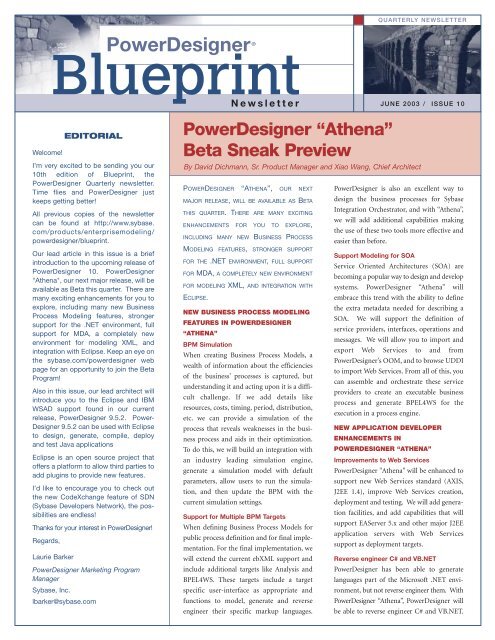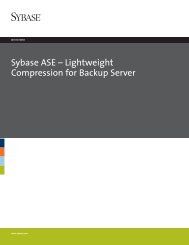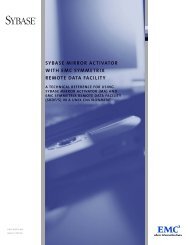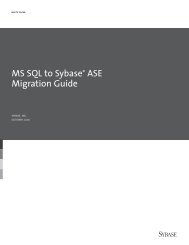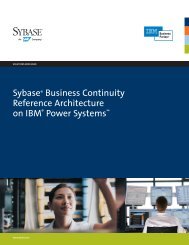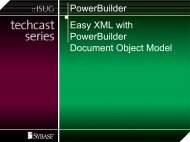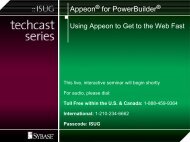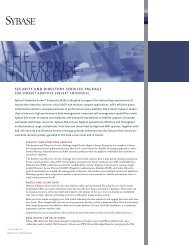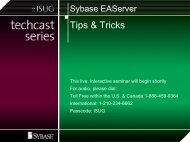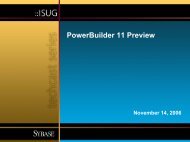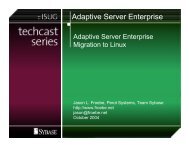PowerDesigner® - Sybase
PowerDesigner® - Sybase
PowerDesigner® - Sybase
- No tags were found...
You also want an ePaper? Increase the reach of your titles
YUMPU automatically turns print PDFs into web optimized ePapers that Google loves.
QUARTERLY NEWSLETTERPowerDesigner ®BlueprintNewsletterJUNEEDITORIALWelcome!I’m very excited to be sending you our10th edition of Blueprint, thePowerDesigner Quarterly newsletter.Time flies and PowerDesigner justkeeps getting better!All previous copies of the newslettercan be found at http://www.sybase.com/products/enterprisemodeling/powerdesigner/blueprint.Our lead article in this issue is a briefintroduction to the upcoming release ofPowerDesigner 10. PowerDesigner"Athena", our next major release, will beavailable as Beta this quarter. There aremany exciting enhancements for you toexplore, including many new BusinessProcess Modeling features, strongersupport for the .NET environment, fullsupport for MDA, a completely newenvironment for modeling XML, andintegration with Eclipse. Keep an eye onthe sybase.com/powerdesigner webpage for an opportunity to join the BetaProgram!Also in this issue, our lead architect willintroduce you to the Eclipse and IBMWSAD support found in our currentrelease, PowerDesigner 9.5.2. Power-Designer 9.5.2 can be used with Eclipseto design, generate, compile, deployand test Java applicationsEclipse is an open source project thatoffers a platform to allow third parties toadd plugins to provide new features.I’d like to encourage you to check outthe new CodeXchange feature of SDN(<strong>Sybase</strong> Developers Network), the possibilitiesare endless!Thanks for your interest in PowerDesigner!Regards,Laurie BarkerPowerDesigner Marketing ProgramManager<strong>Sybase</strong>, Inc.lbarker@sybase.comPowerDesigner “Athena”Beta Sneak PreviewPOWERDESIGNER “ATHENA”, OUR NEXTMAJOR RELEASE, WILL BE AVAILABLE AS BETATHIS QUARTER. THERE ARE MANY EXCITINGENHANCEMENTS FOR YOU TO EXPLORE,INCLUDING MANY NEW BUSINESS PROCESSMODELING FEATURES, STRONGER SUPPORTFOR THE .NET ENVIRONMENT, FULL SUPPORTFOR MDA, A COMPLETELY NEW ENVIRONMENTFOR MODELING XML, AND INTEGRATION WITHECLIPSE.NEW BUSINESS PROCESS MODELINGFEATURES IN POWERDESIGNER“ATHENA”BPM SimulationWhen creating Business Process Models, awealth of information about the efficienciesof the business’ processes is captured, butunderstanding it and acting upon it is a difficultchallenge. If we add details likeresources, costs, timing, period, distribution,etc. we can provide a simulation of theprocess that reveals weaknesses in the businessprocess and aids in their optimization.To do this, we will build an integration withan industry leading simulation engine,generate a simulation model with defaultparameters, allow users to run the simulation,and then update the BPM with thecurrent simulation settings.Support for Multiple BPM TargetsWhen defining Business Process Models forpublic process definition and for final implementation.For the final implementation, wewill extend the current ebXML support andinclude additional targets like Analysis andBPEL4WS. These targets include a targetspecific user-interface as appropriate andfunctions to model, generate and reverseengineer their specific markup languages.2003 / ISSUE 10By David Dichmann, Sr. Product Manager and Xiao Wang, Chief ArchitectPowerDesigner is also an excellent way todesign the business processes for <strong>Sybase</strong>Integration Orchestrator, and with “Athena”,we will add additional capabilities makingthe use of these two tools more effective andeasier than before.Support Modeling for SOAService Oriented Architectures (SOA) arebecoming a popular way to design and developsystems. PowerDesigner “Athena” willembrace this trend with the ability to definethe extra metadata needed for describing aSOA. We will support the definition ofservice providers, interfaces, operations andmessages. We will allow you to import andexport Web Services to and fromPowerDesigner’s OOM, and to browse UDDIto import Web Services. From all of this, youcan assemble and orchestrate these serviceproviders to create an executable businessprocess and generate BPEL4WS for theexecution in a process engine.NEW APPLICATION DEVELOPERENHANCEMENTS INPOWERDESIGNER “ATHENA”Improvements to Web ServicesPowerDesigner "Athena" will be enhanced tosupport new Web Services standard (AXIS,J2EE 1.4), improve Web Services creation,deployment and testing. We will add generationfacilities, and add capabilities that willsupport EAServer 5.x and other major J2EEapplication servers with Web Servicessupport as deployment targets.Reverse engineer C# and VB.NETPowerDesigner has been able to generatelanguages part of the Microsoft .NET environment,but not reverse engineer them. WithPowerDesigner “Athena”, PowerDesigner willbe able to reverse engineer C# and VB.NET.
This facility will then allow users to modifyC# and VB.NET code in the Preview window,and provide roundtrip engineering for thesespecific .NET languages to the same level thatJava developers have enjoyed fromPowerDesigner in the recent releases.Stronger Support for MDAModel Driven Architecture (MDA) can bedescribed as a way to define higher levels ofabstraction, and generate from these higherlevelmodels other models of greater degreesof specification. To support MDA, we willneed to add the abilities to define modeltransformation functions using VBScript, toinvoke transformation function before andafter model-to-model generations, and allowusers to select an Extended Model Definition(.XEM) in model-to-model generations.Support Eclipse IDE and EnvironmentPowerDesigner “Athena” will be extended toallow Eclipse-based tools to create Power-Designer diagrams, and interact withPowerDesigner metadata. A new Eclipseplug-in in Java will allow you to usePowerDesigner models inside the EclipseGUI. Other extensions within thePowerDesigner modules will allow bidirectionalsynchronization with files editedin other Eclipse tools. This means two things:we can use PowerDesigner within the JavaIDE (the Eclipse JDT) and have real-timesynchronization of code and models, and wecan also perform this same level of integrationwith other tools, like the <strong>Sybase</strong>Integration Orchestrator, that use the Eclipseframework.THE NEW XML MODELXML in context with Objects and DataThere is a real cost associated with developingwith XML today. The cost of managing XMLcomes from a lack of a specialized modelingtechnique we can use to define, understand,communicate, and change the XML structures.PowerDesigner has traditionallyattempted to address this need using a UMLclass diagram, but this is not the best techniquefor XML structures, they are not purelyobject oriented. Also, Data Modeling is notperfect, since it has none of the object-orientedconcepts that XML can handle.To address this gap, we will introduce a newXML model in PowerDesigner “Athena”. Thismodel will support XML Schema and DTD;it will have a tree view, hierarchy diagram andtext view. The XML Model can be used forimplementing database specific XML Schemasupport.The XML Model will be able to convert XMLSchema to DTD and vice versa, convert DTDto XML Schema. The model will also generateto and from PowerDesigner’s OOM and PDMmodels, and maintain as appropriate an XMLto Data or XML to Object mapping (similarto the O/R mapping technique used inPowerDesigner today to manage the design ofobject persistence, or the Warehouse externalsource mapping).MORE “ATHENA” IMPROVEMENTSTHERE ARE MANY MORE AREAS THROUGHOUTPOWERDESIGNER THAT ARE BEING ENHANCEDIN “ATHENA”. WE ARE IMPROVING THERDBMS SUPPORT LEVELS AND ENHANCINGWAREHOUSE-SPECIFIC CAPABILITIES. WE AREIMPROVING THE METADATA REPOSITORY TOIMPROVE PERFORMANCE AND FLEXIBILITY. WEARE EXTENDING THE OVERALL METADATA MAN-AGEMENT CAPABILITIES, THE OVERALL EASE OFUSE AND PRACTICAL PRODUCTIVITY OFPOWERDESIGNER. PLEASE JOIN THE BETA, TRYOUT THESE NEW FEATURES AND CAPABILITIES,AND HELP US MAKE “ATHENA” THE BESTRELEASE OF POWERDESIGNER YET.PowerDesigner Integration with EclipseBy Xiao Wang, PowerDesigner Chief Architect, <strong>Sybase</strong> Inc.POWERDESIGNER 9.5.2 ADDS ECLIPSE ANDIBM WSAD SUPPORT. YOU CAN USEPOWERDESIGNER 9.5.2 AND ECLIPSE TODESIGN, GENERATE, COMPILE, DEPLOY ANDTEST JAVA APPLICATIONS.ECLIPSE OVERVIEWEclipse is an open source project that offers aplatform to allow third parties to add pluginsto provide new features. For example, a plugincould provide IDE features, modelingfeatures, code generator, etc. You candownload the Eclipse platform and the JavaDevelopment Tool (JDT) for free fromhttp://www.eclipse.org/. The JDT is a JavaIDE that allows users to edit, browse, compileand debug Java classes.Example of the Eclipse JDT:ROUND-TRIP ENGINEERING FOR JAVADEVELOPMENTPowerDesigner and Eclipse enable round-tripengineering for Java development:• Perform high level analysis and designusing PowerDesigner• Design and create Java components inPowerDesigner• Generate Java code and Eclipse project files• Import the project in Eclipse• Finish the implementation of Java classesusing Eclipse JDT or WSAD (WebSphereApplication Developer 5)2
• Compile, package, deploy and debug usingEclipse• Reverse engineer the final Java code to synchronizethe PowerDesigner modelGENERATING ECLIPSE PROJECT FILESAn Eclipse project is stored in a directory. Thename of the project is the name of the directory.A project consists of:• A .project file that defines the name of theproject and the build commands• A .classpath file that defines the sourcedirectory, the binary directory and the listof libraries• Source files and other files• Ant build script for additional buildcommandsPowerDesigner will automatically generatethese files. Depending on the type of Javaclasses, PowerDesigner will also add the necessarybuild tasks and libraries to prevent theusers from doing it manually.With the generated Eclipse Project files, userscan immediately:• Compile Java classes• Package Java classes to create .JAR, .WAR or.EAR files• Deploy the .EAR or .WAR file intoWebLogic, WebSphere, EAServer or TomcatAdding Eclipse ProfileTo generate Eclipse project files, you need tocreate an Object-Oriented Model (OOM)targeted for the Java language, and then addthe Eclipse profile defined in an extendedmodel definition.To add the Eclipse profile:• Select Model>Extended Model Definitions• Click on the Import button• Select the Eclipse profileConfiguring Eclipse, J2EE and JWSDPHome DirectoriesTo generate the .project and .classpath files,you need to define an ECLIPSE_HOME variablethat indicates the Eclipse home directory.If you plan to generate EJBs, Sevlets or JSPs,you will also need to define a J2EE_HOMEvariable. If you will use the Java Web ServicesDeveloper Pack, you will need to define aJWSDP_HOME variable as well.You can define a variable insidePowerDesigner or in the Windows environmentvariables.To define the a variable in PowerDesigner:1) Select Tools>General Options.2) Select the Variables category.3) Insert a variable.4) In the value column, enter the directory pathConfiguring Eclipse VersionBy default, PowerDesigner supports:• Eclipse platform 2.0.2• Xerces 4.0.7• EMF 1.0.1If you are using a different version of Eclipse,you have to change the Eclipse version foryour current model:1) Open the Model property sheet.2) Click on the Extended Attributes tab.3) Enter the versions of Eclipse, Xerces and EMFSelecting a Target Application ServerPowerDesigner 9.5.2 can generate EJBs,Servlets, JSPs and application server specificdescriptors. In the Ant build.xml file,PowerDesigner can generate the target serverspecific deployment commands. If you wantto support a specific application server, youneed to add the application server profile.The supported application servers are:• BEA WebLogic Application Server 6.0• BEA WebLogic Application Server 7.0• IBM WebSphere 5.0• <strong>Sybase</strong> EAServer 4.x• Apache Tomcat 4.1If you want to use WSAD for deploying applicationin WebSphere server, you should usethe WebSphere profile instead of the Eclipseprofile.Verifying the Eclipse Project FilesYou can preview the Eclipse .project, .classpathand Ant build.xml files fromPowerDesigner.To preview the Eclipse project files:1) Open the model property sheet.2) Click on the Preview tab.3) Click on the Eclipse .project tab to previewthe Eclipse .project file.4) Click on the Eclipse.classpath tab to previewthe Eclipse .classpath file.5) Click on the Ant build.xml tab to previewthe Ant build.xml file.Enabling Eclipse Project Files GenerationBy default, the Eclipse project files generationis enabled. If you want to change the generationoption, you can change the "GenerateEclipse .project and .classpath files" generationoption:1) Select Language>Generate Java Code.2) Click on the Options tab.3
3) Set the value of the "Generate Eclipse.project and .class path files" option to trueor false.4) Click on the Apply button to save thesettings.5) Click Cancel to close the window.Generating Java Code and Eclipse ProjectFilesTo generate all the Java code for EJBs, Servletsand JSPs along with the Eclipse project files:1) Select Language>Generate Java Code.2) Select the project directory where youwant to generate the files. The name ofthis directory will be used as the projectname.3) Select the packages, classes and interfacesyou want to generate in the Selection page.4) Set the generation options for Java, EJBand the target application server in theOptions page. To be able to deploy theapplication in an application server, youneed to enter the server name, port number,user name and password.5) You do not need to select any commandtask in the Tasks page.6) Click OK to generate the Java code and theEclipse project files.BUILDING AND DEPLOYING A JAVAAPPLICATION USING ECLIPSEYou should start Eclipse using the eclipse.exeprogram to work on the generated Java project.If the Java project is a new project, youneed to import it into the Eclipse workspace.If the Java project is an existing project, youneed to refresh the project.Importing a Project into the EclipseWorkspaceTo import the generated Eclipse project intothe Eclipse workspace:1) Select File>Import.2) Select “Existing project into workspace”as the import source then click on next.3) In the directory selection window, selectthe project directory where you have generatedthe code.4) Click on Finish.Refreshing a ProjectWhen you regenerate Java code fromPowerDesigner or modify some files outsideEclipse, you need to refresh the project. Torefresh a project:1) Right-click the project in the EclipsePackage Explorer.2) Select Refresh.Compiling and Packaging Java FilesFor a J2EE application, PowerDesigner generatesa packaging command. The packagingcommand uses the pack task of the Antbuild.xml file. The packaging command isautomatically invoked when Eclipse compilesJava files.When you refresh or rebuild a project, all theJava files will be compiled and packaged.When you save a Java file, the file will be compiledand packaged.You can also recompile and repackage all theJava files:1) Select the project in the Eclipse PackageExplorer.2) Select the Project>Rebuild Project menucommand.Deploying EJBs, Servlets and JSPsTo deploy EJBs, Servlets and JSPs into an applicationserver:1) Right-click the build.xml file in theEclipse Package Explorer.2) Select Run Ant.3) In the Run Ant window, select the deploytask.4) Click on Finish.GENERATING WSAD PROJECT FILESPowerDesigner can generate an IBMWebSphere Application Developer 5.0 projectfiles including EJBs and O/R mapping descriptorsfor WebSphere Application Server 5.0.To generate WSAD project files, you need touse the WebSphere profile instead of theEclipse profile.CUSTOMIZING ECLIPSE ANDWEBSPHERE GENERATIONThe Eclipse and WSAD project files generationin PowerDesigner 9.5.2 are entirelydefined in the Eclipse and WebSphereprofiles. You can customize the generationtemplates if necessary.ECLIPSE EMF ECORE MODELGENERATIONEMF (Eclipse Modeling Framework) uses aninternal metamodel called Ecore. Ecore is asubset of MOF.PowerDesigner can generate the Ecore modeland an Eclipse project to allow you to use theEMF code generator to generate a completeJava API for your model.CONCLUSIONPOWERDESIGNER 9.5.2 AND ECLIPSE JDTPROVIDE COMPLETE ROUND-TRIP SOLUTIONFOR J2EE APPLICATION DESIGN, GENERATION,DEVELOPMENT, DEPLOYMENT AND DEBUGGING.THE EMF ECORE MODEL GENERATION ALLOWSYOU TO TRANSFORM AN ANALYSIS CLASSDIAGRAM INTO A FULLY FUNCTIONAL JAVA API.POWERDESIGNER 9.5.2 PROVIDES A GOODINTEGRATION SOLUTION WITH ECLIPSE TODAY.IN THE FUTURE, WE WILL PROVIDE AN EVENBETTER INTEGRATION.4
New Resource for PowerDesigner UsersExtend PowerDesigner With Files From SDN CodeXchangeSYBASE IS EXCITED ABOUTOFFERING DEVELOPERS AND DBASWHAT YOU’VE BEEN ASKING FOR! INEARLY APRIL, SYBASE LAUNCHEDA NEW RESOURCE EXPRESSLYFOR ITS TECHNICAL COMMUNITY.CODEXCHANGE, FROM THE SYBASEDEVELOPER NETWORK (SDN),ALLOWS FOR THE FREE EXCHANGEOF CODE SAMPLES, EXTENSIONFILES, AND OTHER TOOLS.Content in CodeXchange is not supportedby <strong>Sybase</strong>, but can come from any <strong>Sybase</strong>user, customer, or employee—all of whombenefit in return from the contributions ofothers. CodeXchange also hosts collaborativedevelopment projects, like open source utilities,where users can work together on a toolin development. <strong>Sybase</strong> is sponsoringCodeXchange solely for the benefit of SDNmembers and customers. And now we wantto invite PowerDesigner users to contributeyour sample models, VB Scripts, modifieddatabase or language definition files and anyother PowerDesigner extension files. Let’scontinue to grow the PowerDesignercommunity!CodeXchange is organized around projects;project “communities” address specificproducts, such as PowerDesigner. In eachproject, CodeXchange provides thefollowing features to facilitate communicationand involvement:• File sharing—to share extension files• Code revision control (CVS)• Mailing lists• Issue and bug tracking• Customizable project pages• Web-base, secure environmentAny SDN member can access CodeXchangeby signing in to My<strong>Sybase</strong> or SDN from the<strong>Sybase</strong>.com site. You can then browse existingprojects, join projects, and suggest newprojects. You can download a file or tool youfind in a particular project; and more important,you can submit files or other tools thatyou have created.Need a database definition file for a databasethat PowerDesigner does not support?Would a VB Script which moves informationfrom a data model into an Excel spreadsheetbe helpful? How about an extended modeldefinition showing one method of handlingmulti-language requirements? Find one onCodeXchange, download it, and even updateit and submit it back if you want.Have you created your own customizationfile that other PowerDesigner users mightfind useful? Submit it at http://powerdesigner.codexchange.sybase.com, and make a namefor yourself in the community.The level of involvement is up to you; youcan observe, or you can assign or fix defectsin the code you find, communicate withother members via mailing lists, and submityour own work. The more people that contribute,the more valuable the communitywill be for its members, so we’re looking foreager participents .Check out CodeXchange via SDN atwww.sybase.com/developer. Ifyou’re not anSDN member yet, you can join there too. Seeyou there!Top10Reasons to Join thePowerDesigner 10.0Beta Program1. Try the new Business Process Model simulation feature and see how you can improve your business and reduce cost2. See how you can use the new Business Process Model to implement SOA, assemble Web Services, generate and reverse engineer BPEL4WS3. Try the improved Web Services for Java using Apache Axis4. Import/export Web Services between OOM and BPM5. Use the new XML Model to graphically define XML Schema, generate XML Schema and reverse engineer6. Reverse engineer your VB .NET and C# code for full round-trip engineering for .NET7. Create your model templates and use them to create new models8. Define your transformation functions for model-to-model generation to implement MDA9. Provide direct input on the evolution of new features, while interfacing directly with <strong>Sybase</strong> engineering and product management.10. Join disucssions and attend web seminars reserved exclusively for registered Beta participantsKeep a close eye on www.sybase.com/powerdesigner for open registration to the Beta!5


